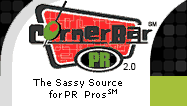
Best Practices
How to Create an Attractive, Readable Publication - Without Killing Your Art Director
By Ann Wylie
Originally Posted
Updated
Just to assure you that yours is not the most ridiculous art director who ever roamed the earth, let's start by talking about David Carson. Carson is the guy who turned publication design on its head in the mid-1990s with the magazines Beach Culture and Ray Gun. He launched the craze for type scored in half, positioned in wheels, layered over itself, and run backwards. In fact, Carson once designed a headline at Ray Gun so it read something like this:
*&%$#@* *$##@%&+
Then, deciding that a symbol font worked pretty damn well for the headline, he ran the story, an interview with a rock star, in dingbats as well. Now, I'm not saying that David Carson is a bad person, or even a bad art director. In fact, we know he's cool, because David Byrne of the "Talking Heads" said he was. But -- and here's where I get to sound like your grandma -- just because it's cool, Sonny, doesn't mean it's the right thing to do. That's the issue that troubles most bad relationships between art directors and editors. Art directors want to look cool. Editors want to look cool, too, especially those of us who have always been a little geeky. But more than that, editors want to produce publications our readers can read. (After all, we wrote ’em.) So how do you and your art director design a publication -- not to mention a relationship -- that works? The secret, in part, lies in: 1) Learning enough about design to know what helps (and what hinders) readership, and then … 2) Using what you've learned to serve as the reader's conscience, not as a design dictator who governs the look of the book based on personal preferences. These three tips will get you started.
-
Know how type affects readership When it comes to readability, type's a biggie. For instance, readers read copy set in all caps 12 percent slower than that set in upper and lower case, according to a white paper by the Medill School of Journalism. Alas, art directors love all caps -- mostly, I think, because type stops looking like words and starts looking like a rule when it's set in all upper case. So agree with your art directors up front on a limit: Say, no more than 10 words in all caps. I am not proud to tell you that I have reduced art directors to tears over this issue. One curled up in the fetal position, whimpering something about "visual relief." I tried to comfort him, whispering words of solace: "Honey, could you use a different font instead? Would boldface subheads offer visual relief?" The whole experience gave me a headache and made me vow to restrict my relationships to art directors who have the talent and education to deliver visual relief -- whatever the hell that is -- without running everything in italics, reverse type or all caps.
-
Restrain column widths Columns that are too wide tire readers and make them lose their place. Columns that aren't wide enough are hard to read and make readers feel jittery. Restrained column width has long been a mark of successful design. But now that everyone with a Quark program seems to be certified to serve as a professional designer, columns sprawl out in all directions, growing so wide that only the art director's mother would bother trying to follow them. One simple rule to keep column widths pleasing and easy to read: Keep your line lengths to about 39 characters. Think of it as an alphabet and a half. A good line length contains 26 letters, just like the alphabet, plus 13, or half again that number.
-
Remember: Art can be the story The best art directors don't just make your story look good. They also suggest different ways to tell the story. This is on my mind right now because of all the fuss over graphic novels. Graphic novels are extended-length "comic books" with a dramatic narrative. They've been around awhile. (Remember Art Spiegelman's poignant Maus? If not, get it today.) But now they're in the news because "The Road to Perdition" and other recent movies were based on these comic book-novel hybrids. The latest addition to the genre: Into the Air: The Story of the Wright Brothers' First Flight. Famous comic book artist (and my brother!) Bill Wylie illustrated this true story of trial, error, and eventual triumph. Bill's previous work included many traditional superhero comic books for Marvel Comics ("Secret Defenders," "Nomad," "Nightstalker"). But as he worked on this story of two true American heroes, I realized that communicators too often miss the chance to tell our stories through a combination of words and pictures -- in a collaboration of editorial and design. Hmmm … Why not take your art director out to lunch today?
© 2002 Ann Wylie. All rights reserved.

